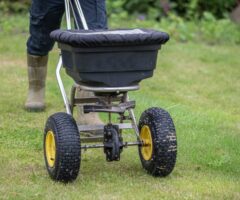As the leaves change and the weather cools in autumn, gathering outdoors becomes less common as we seek warmth and comfort indoors. But Michigan’s cold fall weather doesn’t need to mark the end of your outdoor season! There are simple things you can do to create a warm, inviting space in your own backyard that will extend the outdoor season in comfort and style.
Keep reading for ideas that will help you enjoy more time in your yard this fall no matter the weather!
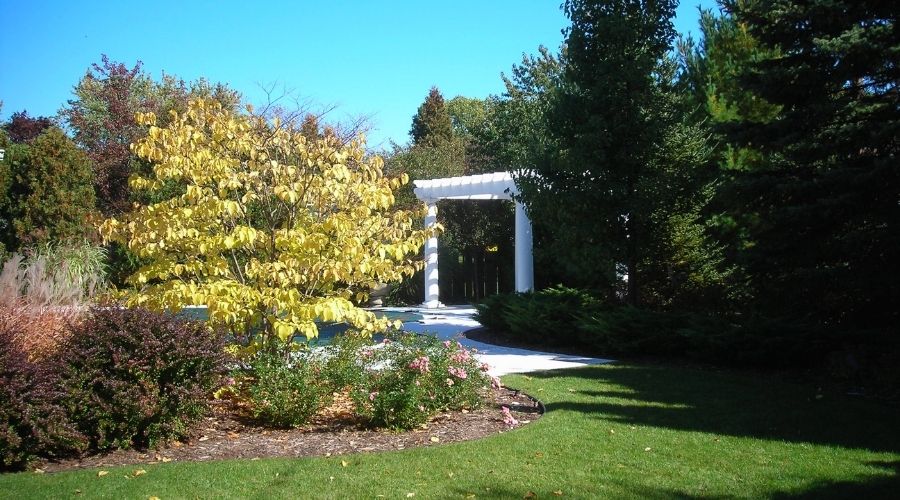
Block the Wind
Cold wind can make sitting outdoors in autumn an uncomfortable experience. But there are ways to block or redirect the wind to help create an outdoor space that can be used well into fall.
For example, evergreen trees and shrubs can be used as beautiful and effective wind blocks. They also have the added benefits of providing privacy, reducing noise (such as from a nearby road or noisy neighbors), and reducing your winter energy costs.
The key is to plant evergreens in the right location and configuration. First, make sure you know the direction of the prevailing wind on your property (or where wind most commonly comes from). A windbreak won’t help if it’s downwind from the area you’re trying to protect!
Then decide which evergreen trees or colorful shrubs you want to plant and how they’ll be used. If they’ll be grown as a hedge (such as with arborvitae), you can plant them in a straight line for a narrow space or in a zig-zag pattern for a wider, denser hedge. For a larger landscape windbreak, use conifers planted in a large zig-zag pattern.
Always keep the mature size of the plant in mind so they don’t end up overcrowded. Yes, it may take a while to get the full benefit of your newly planted windbreak, but that’s better than having to cut them down when they become overcrowded and start to die.
- Contact the Bay Landscaping nursery to learn which trees or shrubs would work best as a windbreak for your property.
- Check Ask the Expert for our recommended deer-resistant evergreens that make effective year-round screening.
While evergreens are a natural way to block wind, reduce noise, and create privacy, you can also install a building, wall, fence, or other forms of hardscaping to block the wind. Unlike a planted windbreak, these structures will create an instant wind block. We recommend working with a landscape designer to make sure your built windbreak is properly sited and the right size to get the effect you want.
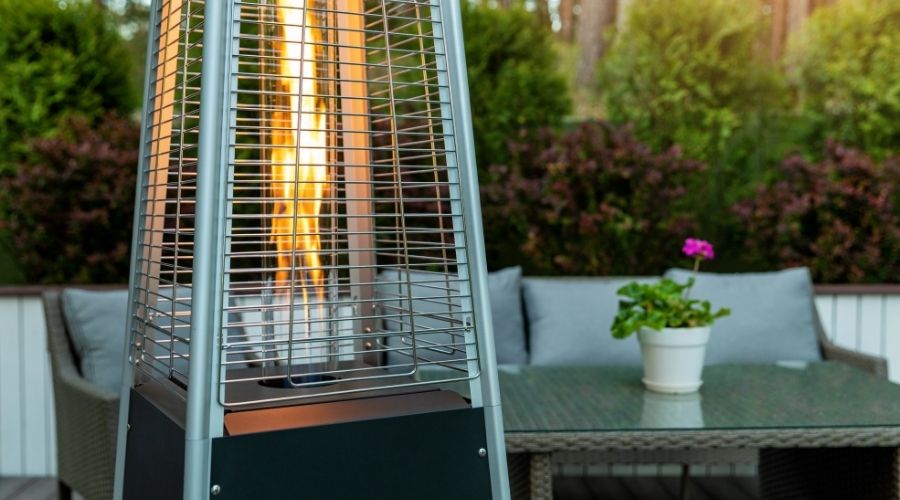
Add Sources of Warmth
While blocking the wind will help with the drop in temperature, finding other ways to increase the warmth of your outdoor living space will make time spent there more comfortable.
If you have the space, installing an outdoor fireplace or a firepit can bring the warmth of a fire to your backyard. It can make even a chilly fall night seem downright cozy.
Portable firepits are another great option. Place one in an area covered by sand, gravel, concrete, pavers, or other material that won’t alight if a spark lands on it. Also, make sure that you don’t have any overhanging branches or part of a building directly above the fire.
Warmth can be added with the use of outdoor heaters as well. Some can even be used as an alternative heating source for screened porches and other outdoor spaces. But please make sure you understand the safety precautions required for their use. It’s not worth keeping warm if it causes an accidental fire!
Finally, having some warm blankets can go a long way in making an outdoor space feel more comfortable as temperatures drop. You and your guests can bundle up under some blankets and drink a warm beverage to enjoy the fall season.
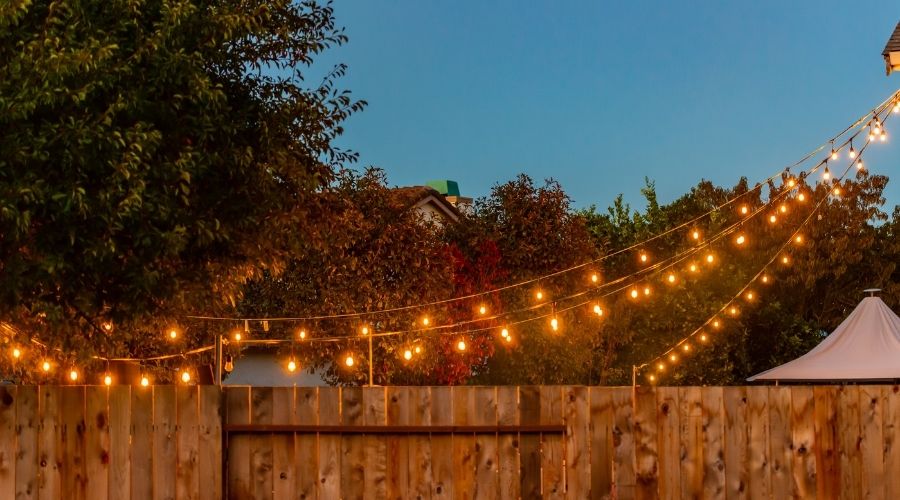
Increase the Light
Not only is the weather getting cooler, but it’s also getting dark earlier as winter approaches. If you want to continue using your outdoor space, you may need to add outdoor lighting.
Simple options for additional outdoor lighting include:
- Hang strings of lights in trees, on your porch roof or railings, from a pergola, or anywhere else you need light. There are many energy-efficient LED options available.
- Use outdoor lanterns. Hang them from trees, shepherd’s hooks, and porch posts or simply place them on tables or the ground. Battery-powered candles are a great alternative to real candles; some even flicker like the real thing.
- LED rope lighting can be wound around columns, railings, and posts to cast a nice glow. Many can be controlled by remote control and can even change colors.
Adding permanent outdoor lighting is also an option, such as landscape lighting and sconces on the side of your house.
Remember, however, that one appeal of the outdoors at night is to see the stars shine. Light pollution is real and can affect our ability to see the stars. In fact, the area around Saginaw, Bay City, and Midland have some of the worst light pollution in the state.
To help bring attention to the problem of light pollution, the Michigan State Senate recently adopted a resolution formally recognizing July 2021 as Dark Sky Awareness Month in the state.
Follow these basic guidelines to minimize light pollution:
- Choose lighting that shines downward
- Pick warmer lighting options when possible
- Only turn on lights when needed
Michigan Dark Skies has many other solutions for light pollution.
Some municipalities (such as Ann Arbor, MI) have “dark sky” ordinances and/or regulations to prevent light pollution, and more cities are considering it. Check with your local government before purchasing any new lighting options.
We can help you find and plan your perfect outdoor lighting solutions as part of our Landscape Design services.

Adding seasonal plants and decor can not only bring some festive cheer to your yard, it can help extend the time you spend out of doors.
Plant Fall Containers
We love container gardening, especially when using AquaPots, and there are endless options for what you can grow in containers.
You can even grow evergreen shrubs in containers to create instant privacy and wind protection. Just make sure the containers can withstand Michigan’s freezing winter weather – most containers (including AquaPots) can’t.
A fall-themed container can bring color and seasonal interest to your outdoor space. As fall turns to winter, there are even winter-themed containers, such as our porch pots, to choose from.
Using live plants will get you into the habit of going outdoors no matter the weather, as they need to be watered (though less so in an AquaPot) and cared for.
Plus, you can grow fresh herbs in containers until it freezes, use the herbs in your fall cooking, and bring the herbs indoors for the winter months.
No matter what you choose to grow, containers can bring color, life, and décor to your outdoor space, even in autumn.
Add Cover Overhead
Adding some kind of covering to your outdoor space can protect you from the elements, including rain, snow, or wind. Having an overhead structure or roof helps keep the area below it warmer and creates the feel of an “outdoor room.” Plus, it creates a centralized place to gather, making it more likely that you’ll want to spend time outdoors.
But pick your overhead cover carefully and understand its limitations. For example, umbrellas and awnings work well in fall, but only until the snow starts to fall. Store your umbrella and have your awning taken down well before snow is expected.
Permanent overhead structures, such as pergolas, gazebos, and roofs, have different considerations. Roofs (including those on a gazebo), for example, must be able to withstand the weight of winter snow loads. And if there’s shade cloth or dense vines covering your pergola, you’ll want to either remove the fabric or prune back the vines to avoid damage from heavy snow.
For some of the more permanent structures, there are options to add screens, windows, or even insulation to make it a true “all seasons” room.
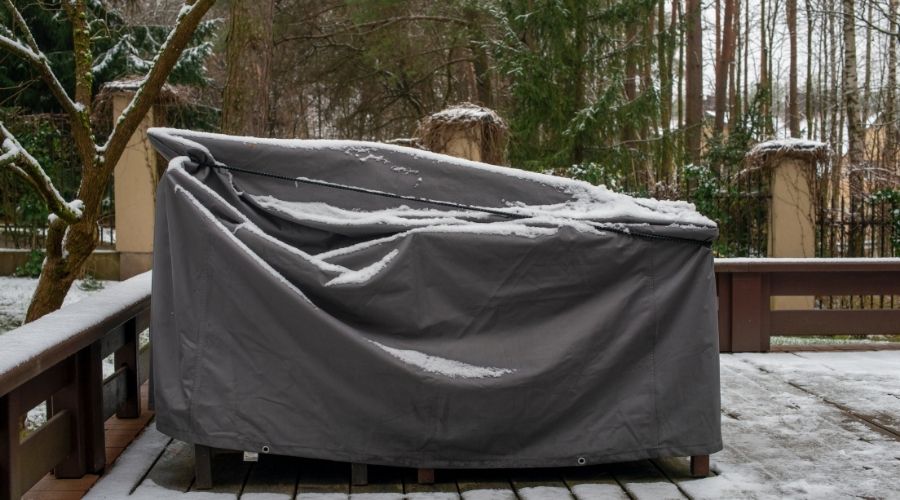
Weatherproof Your Furniture
Speaking of the elements, if you plan to keep furniture outdoors, you will want to weatherproof your furniture. Wind, rain, snow, and sun can all cause damage to anything outdoors, so it’s worth looking into the best way to keep your furniture looking as good as new. Plus, no one wants to sit on wet cushions or wrap themselves in a moldy blanket!
Some easy options include:
- using removable covers when the furniture is not in use,
- applying varnish or sealer to your wooden furniture,
- having a secure place to store cushions, pillows, and anything that can be blown away, and
- using waterproof or sun-resistant fabrics.
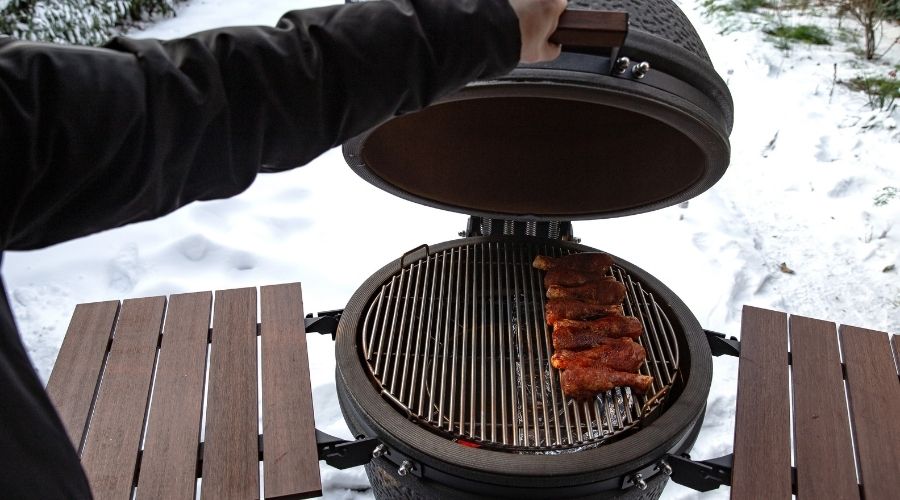
Keep Grilling
Grilling is usually associated with summertime picnics and cookouts, but you can use your grill any time of year. In fact, you can even make a Thanksgiving turkey on the grill!
If there is snow when you plan to grill, create a pathway to your grill and ensure all snow and ice is removed from the grill and the area around it.
Check if your fuel is safe to keep outdoors. Propane, for instance, should be okay outdoors all year, even during the winter months. It’s also okay to keep propane canisters in a garage or shed, but they should never be stored inside your home.
Read more tips for winter grilling from Williams Sonoma.
Enjoy Fall Outdoors!
While there are endless ways to help you enjoy your outdoor space this fall, the best option is to do whatever works for you and your landscape. If you enjoy birdwatching, for instance, you may be drawn outdoors by colorful plumage. A meteor shower may encourage stargazing on a chilly evening. Or warm apple cider with friends might be the perfect escape to gather outdoors.
Whatever the reason, we hope that this article has inspired you to spend time outside no matter the season and to appreciate your yard, garden, and landscaping during all times of the year.
And if your time outdoors inspires some new landscaping ideas, the Bay Landscaping design team is available to help you plan improvements for your yard.





